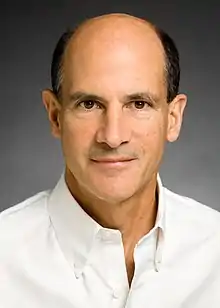Thomas A. Rando
Thomas A. Rando is an American neurologist. Rando is best known for his research on basic mechanisms of stem cell biology and the biology of aging, as well as for contributions to the study of the muscular dystrophies and the emerging field of regenerative rehabilitation. He is a Professor of Neurology and Neurological Sciences at Stanford University School of Medicine, where he is founding director of the Glenn Center for the Biology of Aging. Rando is also Chief of Neurology at the VA Palo Alto Health Care System.
Thomas A. Rando | |
|---|---|
 | |
| Occupation | Professor |
| Academic background | |
| Alma mater | Harvard College. Harvard Medical School |
| Academic work | |
| Discipline | Neurology |
| Institutions | Stanford University School of Medicine |
Biography
He is Deputy Director of the Stanford Center on Longevity.[1]
Research
Stem cell biology
Rando’s research on stem cells has addressed how stem cells in tissues throughout the body maintain their potency to participate in tissue homeostasis and tissue repair throughout the life of an organism. Through these studies, he and his students and fellows have explored the basic mechanisms by which stem cells maintain a dormant, or “quiescent” state, when not engage in generation of new tissue.[2][3] They have explored the connection between this quiescent state and retained stem cell potency and they have discovered a phenomenon of a “quiescence cell cycle” that stem cells can exhibit, with different phases of that cycle manifesting different levels of dormancy.[4] Rando’s group has also contributed to the field of stem cell therapeutics for injury and disease by combining basic stem cell biology with bioengineering approaches.[5]
Cellular aging and rejuvenation
Rando’s laboratory was the first to use the technique of heterochronic parabiosis to explore the effects of the systemic circulation on stem cell function.[6][7] Rando’s group has pioneered studies of the epigenetics of stem cell aging, exploring the role of “epigenetic rejuvenation” as an explanation for the paradigm-shifting findings of heterochronic parabiosis.[8][9] These studies have revealed how exercise itself can lead to rejuvenation of aged stem cells.[10]
Honors
Elected to:
References
- "People at the Stanford Center on Longevity". longevity.stanford.edu. Retrieved 2020-06-30.
- Bjornson, Christopher R. R.; Cheung, Tom H.; Liu, Ling; Tripathi, Pinky V.; Steeper, Katherine M.; Rando, Thomas A. (2012). "Notch Signaling Is Necessary to Maintain Quiescence in Adult Muscle Stem Cells". Stem Cells. 30 (2): 232–242. doi:10.1002/stem.773. ISSN 1549-4918. PMC 3384696. PMID 22045613.
- Cheung, Tom H.; Quach, Navaline L.; Charville, Gregory W.; Liu, Ling; Park, Lidia; Edalati, Abdolhossein; Yoo, Bryan; Hoang, Phuong; Rando, Thomas A. (February 2012). "Maintenance of muscle stem-cell quiescence by microRNA-489". Nature. 482 (7386): 524–528. doi:10.1038/nature10834. ISSN 0028-0836. PMC 3292200. PMID 22358842.
- Rodgers, Joseph T.; King, Katherine Y.; Brett, Jamie O.; Cromie, Melinda J.; Charville, Gregory W.; Maguire, Katie K.; Brunson, Christopher; Mastey, Namrata; Liu, Ling; Tsai, Chang-Ru; Goodell, Margaret A. (2014-06-19). "mTORC1 controls the adaptive transition of quiescent stem cells from G0 to GAlert". Nature. 510 (7505): 393–396. doi:10.1038/nature13255. ISSN 0028-0836. PMC 4065227. PMID 24870234.
- Quarta, Marco; Cromie, Melinda; Chacon, Robert; Blonigan, Justin; Garcia, Victor; Akimenko, Igor; Hamer, Mark; Paine, Patrick; Stok, Merel; Shrager, Joseph B.; Rando, Thomas A. (20 June 2017). "Bioengineered constructs combined with exercise enhance stem cell-mediated treatment of volumetric muscle loss". Nature Communications. 8: 15613. doi:10.1038/ncomms15613. ISSN 2041-1723. PMC 5481841. PMID 28631758.
- Toledano, Hila (2014-04-06). "Faculty Opinions recommendation of Rejuvenation of aged progenitor cells by exposure to a young systemic environment". Faculty Opinions – Post-Publication Peer Review of the Biomedical Literature. doi:10.3410/f.1024195.793493221. Retrieved 2020-06-30.
- Brack, Andrew S.; Conboy, Michael J.; Roy, Sudeep; Lee, Mark; Kuo, Calvin J.; Keller, Charles; Rando, Thomas A. (2007-08-10). "Increased Wnt Signaling During Aging Alters Muscle Stem Cell Fate and Increases Fibrosis". Science. 317 (5839): 807–810. doi:10.1126/science.1144090. ISSN 0036-8075. PMID 17690295. S2CID 6767424.
- Rando, Thomas A.; Chang, Howard Y. (2012-01-20). "Aging, Rejuvenation, and Epigenetic Reprogramming: Resetting the Aging Clock". Cell. 148 (1): 46–57. doi:10.1016/j.cell.2012.01.003. ISSN 0092-8674. PMC 3336960. PMID 22265401.
- Sarkar, Tapash Jay; Quarta, Marco; Mukherjee, Shravani; Colville, Alex; Paine, Patrick; Doan, Linda; Tran, Christopher M.; Chu, Constance R.; Horvath, Steve; Qi, Lei S.; Bhutani, Nidhi (2020-03-24). "Transient non-integrative expression of nuclear reprogramming factors promotes multifaceted amelioration of aging in human cells". Nature Communications. 11 (1): 1–12. doi:10.1038/s41467-020-15174-3. ISSN 2041-1723. PMID 32210226.
- Brett, Jamie O.; Arjona, Marina; Ikeda, Mika; Quarta, Marco; de Morrée, Antoine; Egner, Ingrid M.; Perandini, Luiz A.; Ishak, Heather D.; Goshayeshi, Armon; Benjamin, Daniel I.; Both, Pieter (April 2020). "Exercise rejuvenates quiescent skeletal muscle stem cells in old mice through restoration of Cyclin D1". Nature Metabolism. 2 (4): 307–317. doi:10.1038/s42255-020-0190-0. ISSN 2522-5812. PMC 7323974. PMID 32601609.
- Maguire, Katie K.; Lim, Leland; Speedy, Sedona; Rando, Thomas A. (May 2013). "Assessment of disease activity in muscular dystrophies by noninvasive imaging". The Journal of Clinical Investigation. 123 (5): 2298–2305. doi:10.1172/JCI68458. ISSN 1558-8238. PMC 3638910. PMID 23619364.
- Filareto, Antonio; Maguire-Nguyen, Katie; Gan, Qiang; Aldanondo, Garazi; Machado, Léo; Chamberlain, Jeffrey S.; Rando, Thomas A. (2018-07-24). "Monitoring disease activity noninvasively in the mdx model of Duchenne muscular dystrophy". Proceedings of the National Academy of Sciences. 115 (30): 7741–7746. doi:10.1073/pnas.1802425115. ISSN 0027-8424. PMC 6064991. PMID 29987034.
- "2015 AAAS Fellows Recognized for Contributions to Advancing Science". American Association for the Advancement of Science. Retrieved 2020-06-30.
- "Class of 2016". National Academy of Medicine. Retrieved 2020-06-30.
- "New Members". American Academy of Arts & Sciences. Retrieved 2020-06-30.
External links